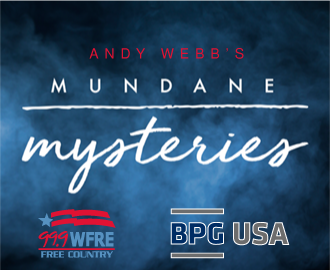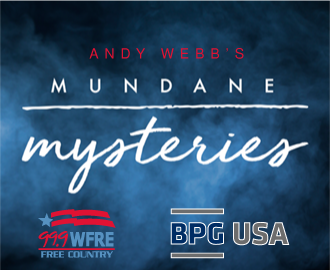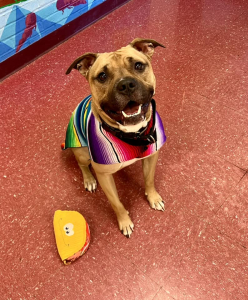MUNDANE MYSTERIES: Why Do We “Ring In The New Year”?

Whenever people start talking about “ringing in the New Year”, you’ll usually hear them talk about doing so with things like a kiss, a toast, a New Year’s resolution, a movie marathon, or an entire dozen donuts all to themselves. But when you think about it…none of those things ring, do they? So, why do we say that we’re “ringing in” the New Year? Well, because when that phrase first sprang up, it was because New Year’s celebrations involved things that actually do ring (bells).
Communities used to send off the old year & welcome the new one by ringing bells, usually church bells, a tradition that grew out of other instances where bells were used to mark important occasions: “passing bells”, which tolled for someone who’d died, and “wedding bells”, which celebrated the beginning of a couple’s union.
Decades before throngs of thousands began flocking to Times Square to witness the famous ball drop (which first took place in 1907), they gathered a little ways further downtown at Trinity Church on Wall Street. There, they would ring in the New Year with a full-on concert performed by the church’s official bell ringer, James E. Ayliffe. According to an 1860 New York Herald story, “there floated from the high church tower the stirring music of eight bells chiming in changes & making the air redolent with harmony. This was followed by ‘Hail Columbia’, ‘Yankee Doodle’, and some sweet selections from ‘La Fille du Regiment’.” I mean, as you can see…he clearly put on a show!
Yet, while the earliest mention of that tradition in Trinity Church’s archives was listed in the minutes of an 1801 meeting, where parishioners allotted eight pounds to “the Persons who ring the Bells on New Year’s Day”, the truth is that the whole thing could very well have been going on well before then (especially when you consider that the church’s first bell was obtained back in 1698).
But in short, the ringing of bells was once a huge, central part of the New Year’s holiday. But as it’s place in the festivities has faded from memory, “ringing in” the New Year no longer makes much sense…unless you know the phrase’s history (which now you do).
Got a Mundane Mystery you’d like solved? Send me an email: [email protected]!
BROUGHT TO YOU BY: BPG USA
House of the Week – 12/29/23

🏡🌿 Introducing your dream farmette at 2257 E Mayberry Rd, Westminster! Dive into rural charm with this spacious 4-bedroom, 2 full and 2 half bath home spread across nearly 5.5 acres.
What’s special?
🐴 Perfect for animal lovers: Barn, fenced pastures, run-in, and Nelson automatic waterers
🏊♂️ A stunning in-ground pool with a large patio – ideal for hosting
🌞 Relax in the sunroom with views over the fields
🔥 Cozy up with a wood stove in the family room & a pellet stove in the basement
🚗 Freshly painted house & garage
Home Features:
🎨 Brand new carpet, ceramic tile in the kitchen, and newly refinished hardwood floors
🍳 Modern kitchen with granite countertops and newer appliances
🌤️ Bright, airy sunroom and a spacious living area
🛋️ Finished basement with a walkout to the pool
Set on a private lot, this home is still conveniently close to commuter routes and dining options.
Ready for the country life with all the comforts? Schedule your private tour today! 🚜🏠 #RuralRetreat #WestminsterWonder
Wake Up Crew Highlights: December 29, 2023
MUNDANE MYSTERIES: Why Do We Call It “Eggnog”?

You probably had eggnog over Christmas. (Heck, you probably still have some eggnog leftover in your fridge right now). But while it’s definitely delicious, why is it called “eggnog”?
The “egg” part doesn’t really need an explanation, does it? Eggs are the foundation of eggnog, with their yolks usually being combined with other elements like milk, sugar, alcohol, and spices before whisking in beaten egg whites. But what about the “nog” part? Well, eggnog’s second syllable isn’t quite as straightforward as its first, but we can look to some old-fashioned words for its potential genesis.
First, there’s the Noggin Theory. Before it became a slang term for “head”, “noggin” described a small drinking container like a cup/mug. The word “noggin” actually dates back to at least the late 1500s. Then, by the mid-1600s, people were using noggin to describe what went into a noggin (which was usually liquor or spirits). Robert Louis Stevenson even mentioned it in Treasure Island in the early 1880s.
Then, there’s the Nog Theory. It’s possible that “eggnog”, which first entered the lexicon by way of an 1825 John Neal novel, arose directly from noggin, since eggnog did contain liquor & you’d usually drink it from a small mug. But by the late 1800s, “nog” had begun showing up as a word of its own, as it was a potent type of beer from Norfolk, England. While today’s eggnog traditionally features liquor, “posset” (the medieval milk drink that inspired eggnog) could also contain ale or wine. Still, it’s not really clear where the word “nog” truly originated. And even if eggnog was inspired by nog, noggin was probably still part of its creation.
And there’s the Grog Theory. In 1740, British admiral Edward Vernon ordered his sailors to start diluting their rum ration with water to avoid consuming their entire allotment all at once. The admiral’s men referred to their leader as “Old Grog” because of the rough silky fabric he wore as part of his uniform, which was called a “grogram”. So, as a jab at the admiral, the sailors co-opted his nickname & began referring to their watered-down drink as “grog”. Interestingly, Treasure Island also mentioned grog, too, which has led some to suggest that eggnog is actually just a truncation of “egg” & “grog.”
I’m not sure what would be more confusing to a server nowadays: ordering a mug of “egg-and-grog”, or asking them to give you a “nog”. Wherever the delicious drink’s name came from, enjoy what’s left of your eggnog & what’s left of 2023!
Got a Mundane Mystery you’d like solved? Send me an email: [email protected]!
